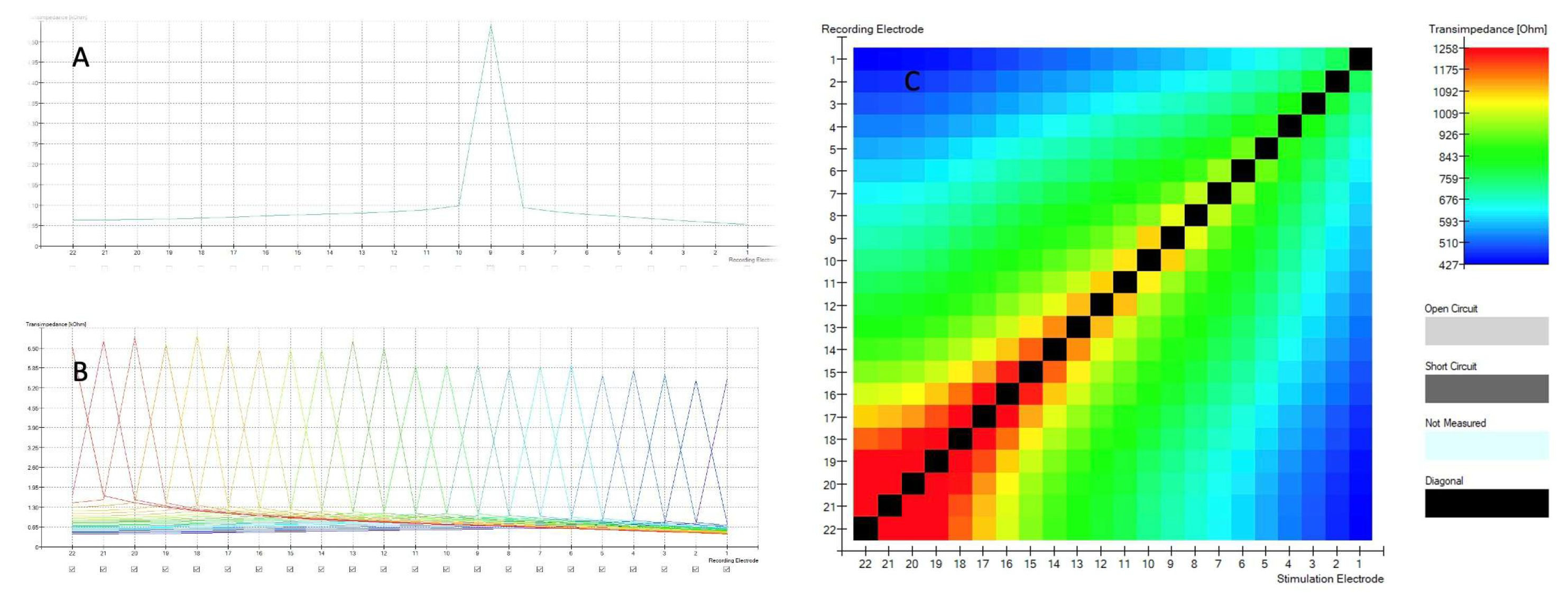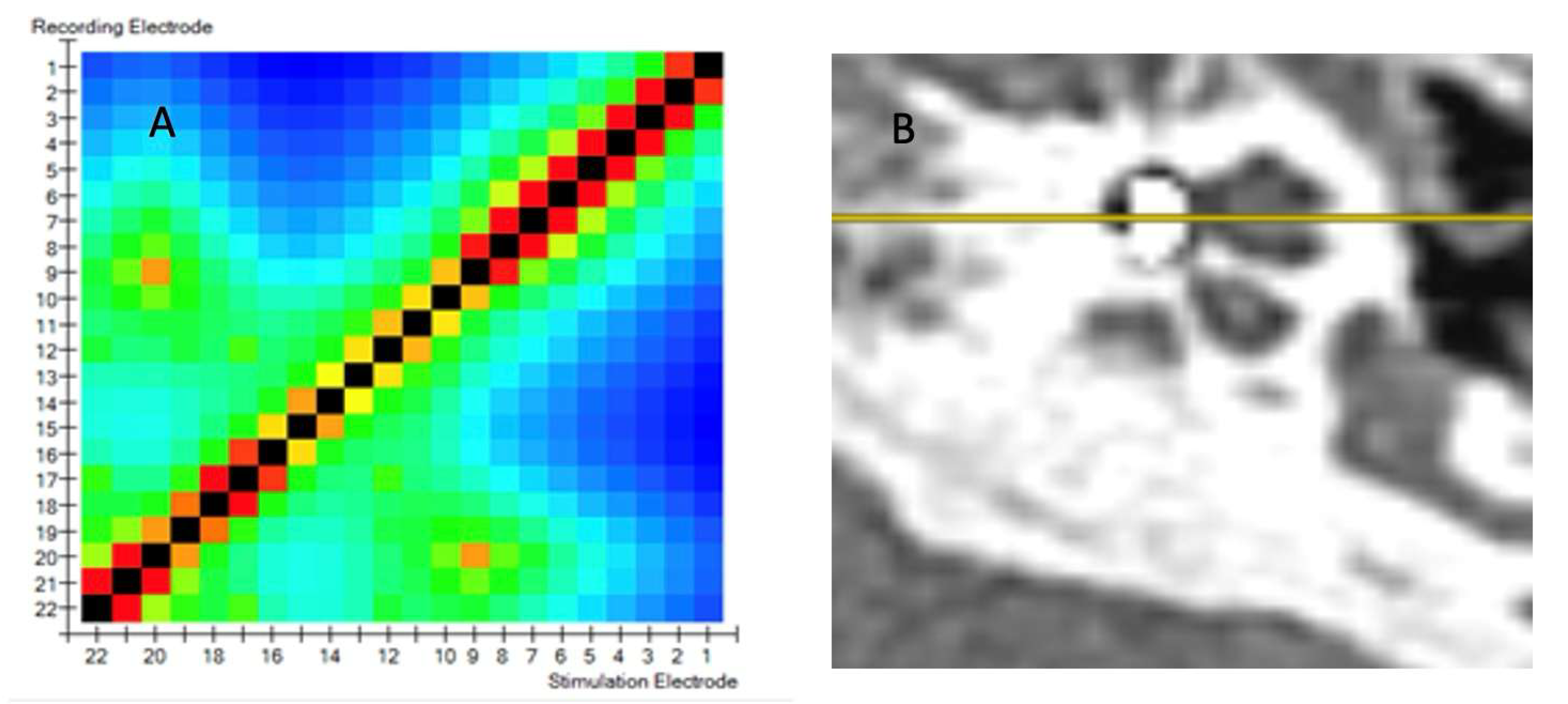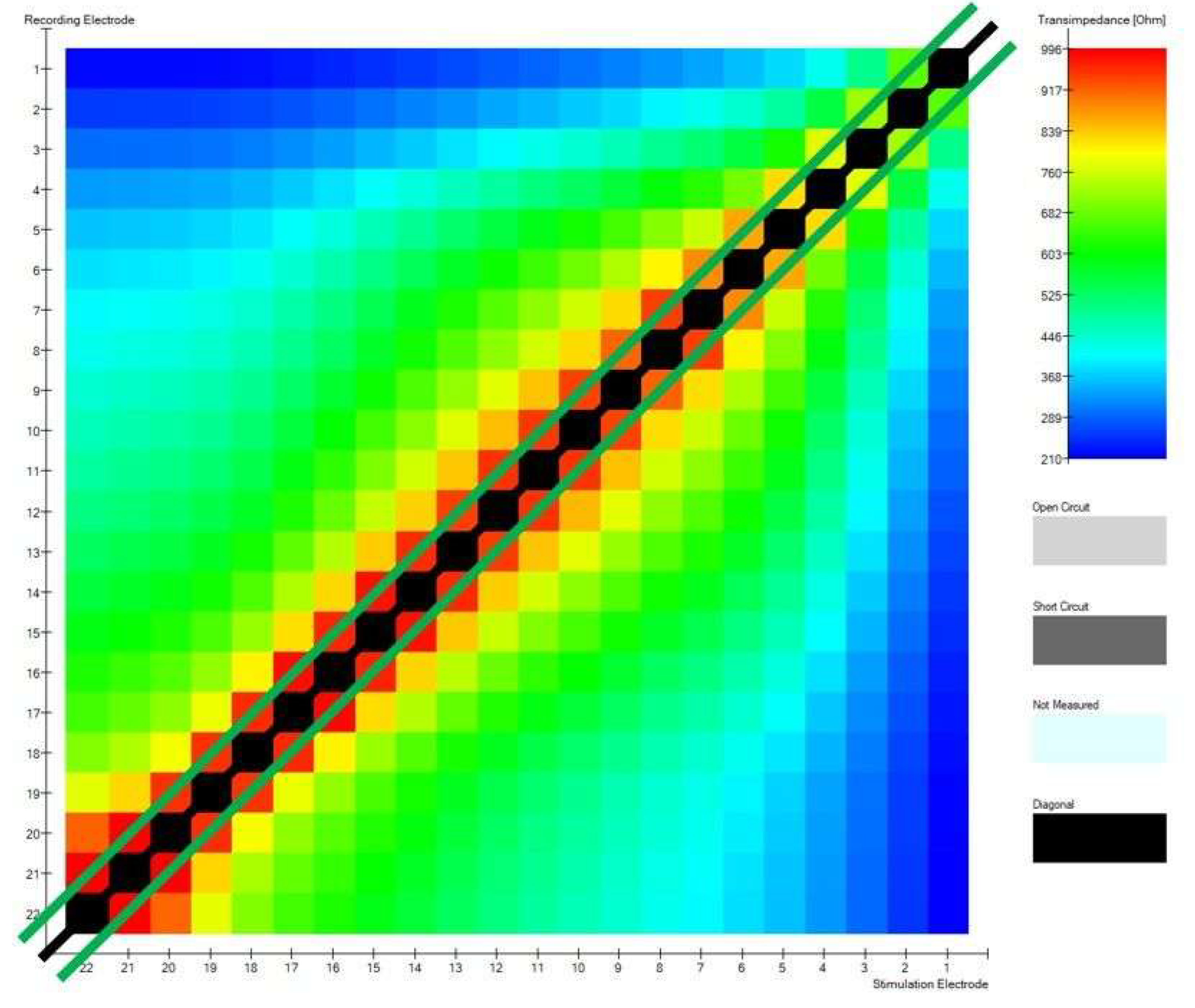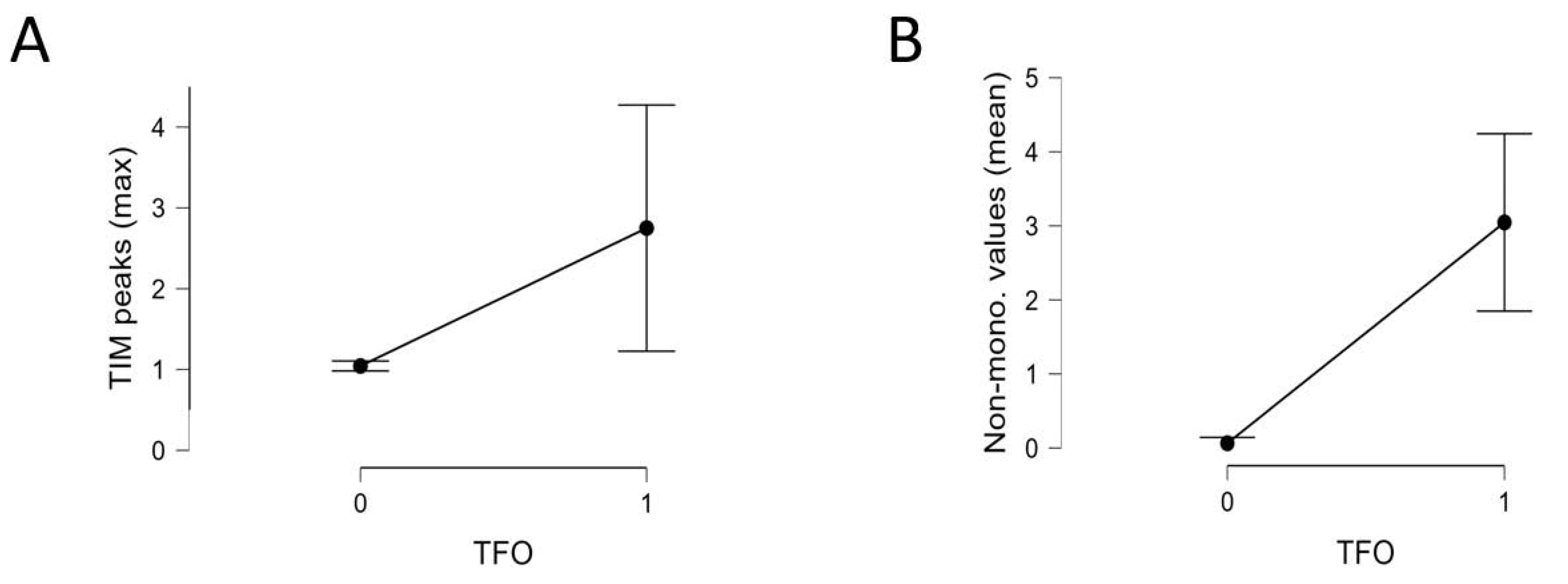Transimpedance Matrix Measurement (TIM) Parameters Evaluation for the Assessment of Cochlear Implant Electrode Placement and Modiolar Proximity in Children
Abstract
1. Introduction
2. Materials and Methods
2.1. Establishing Normative Values for the TIM Measurement
- Mean number of points of non-monotonicity;
- Mean number of peaks in the matrix;
- Maximum number of points of non-monotonicity;
- Maximum number of peaks in the matrix.
- 5.
- Correct construction of the diagonal;
- 6.
- Minimalities on the sub-diagonals.
2.2. Statistical Analysis
3. Results
Comparison of Implant Electrode Array Models
4. Discussion
4.1. Electrode Tip Fold-Over (TFO)
4.2. Perimodiolar Electrode Position and Intraoperative Measurements
5. Conclusions
Author Contributions
Funding
Institutional Review Board Statement
Informed Consent Statement
Data Availability Statement
Acknowledgments
Conflicts of Interest
Appendix A
| Patients Without TFO | ||||||||||
|---|---|---|---|---|---|---|---|---|---|---|
| Mean Number of Points of Non-Monotonicity | Maximum Number of Points of Non-Monotonicity | Mean Number of Peaks in the Matrix | Maximum Number of Peaks in the Matrix | |||||||
| Mean | SD | M | SD | M | SD | M | SD | |||
| Normal anatomy | 0.064 | 0.266 | 0.109 | 0.379 | 1.04 | 0.197 | 1.04 | 0.206 | ||
| Congenital malformation | 0.355 | 0.368 | 1.73 | 1.56 | 1.07 | 0.143 | 1.64 | 1.29 | ||
| Mean | Standard deviation | Sub-diagonal | Diagonal | AutoNRT | ||||||
| M | SD | M | SD | M | SD | M | SD | M | SD | |
| Normal anatomy | 684 | 191 | 550 | 153 | 31.8 | 4.21 | 0.935 | 0.250 | 2.09 | 4.37 |
| Congenital malformation | 980 | 416 | 1039 | 412 | 31.9 | 8.72 | 1 | 0 | 7 | 8.22 |
| All patients | ||||||||||
| Mean number of points of non-monotonicity | Maximum number of points of non-monotonicity | Mean number of peaks in the matrix | Maximum number of peaks in the matrix | |||||||
| Mean | SD | M | SD | M | SD | M | SD | |||
| Normal anatomy | 0.303 | 0.876 | 0.52 | 1.47 | 1.10 | 0.275 | 1.18 | 0.560 | ||
| Congenital malformation | 0.639 | 1.05 | 2.17 | 2.12 | 1.23 | 0.560 | 1.92 | 1.56 | ||
| Mean value | Standard deviation | Sub-diagonal | Diagonal | AutoNRT | ||||||
| M | SD | M | SD | M | SD | M | SD | M | SD | |
| Normal anatomy | 700 | 216 | 578 | 270 | 31.8 | 4.57 | 0.920 | 0.274 | 2.10 | 4.22 |
| Congenital malformation | 1009 | 409 | 1126 | 495 | 31.6 | 8.39 | 0.917 | 0.289 | 7.83 | 8.35 |
References
- Perenyi, A.; Toth, F.; Dimak, B.; Nagy, R.; Schoerg, P.; Jori, J.; Kiss, J.G.; Sprinzl, G.; Csanady, M.; Rovo, L. Electrophysiological measurements with electrode types of different perimodiolar properties and the same cochlear implant electronics—A retrospective comparison study. J. Otolaryngol. Head Neck Surg. 2019, 48, 46. [Google Scholar] [CrossRef] [PubMed] [PubMed Central]
- Aschendorff, A.; Briggs, R.; Brademann, G.; Helbig, S.; Hornung, J.; Lenarz, T.; Marx, M.; Ramos, A.; Stöver, T.; Escudé, B.; et al. Clinical investigation of the Nucleus Slim Modiolar Electrode. Audiol. Neurootol. 2017, 22, 169–179. [Google Scholar] [CrossRef] [PubMed]
- Haber, K.; Neagu, A.; Konopka, W.; Amernik, K.; Gheorghe, D.C.; Drela, M.; Wrukowska-Niemczewska, I.; Mierzwiński, J. The influence of Slim Modiolar electrode on residual hearing in pediatric patients. Eur. Arch. Otorhinolaryngol. 2021, 278, 2723–2732. [Google Scholar] [CrossRef] [PubMed]
- Gabrielpillai, J.; Burck, I.; Baumann, U.; Stöver, T.; Helbig, S. Incidence for Tip Foldover During Cochlear Implantation. Otol. Neurotol. 2018, 39, 1115–1121. [Google Scholar] [CrossRef] [PubMed]
- Zuniga, M.G.; Rivas, A.; Hedley-Williams, A.; Gifford, R.H.; Dwyer, R.; Dawant, B.M.; Sunderhaus, L.W.; Hovis, K.L.; Wanna, G.B.; Noble, J.H.; et al. Tip Fold-over in Cochlear Implantation: Case Series. Otol. Neurotol. 2017, 38, 199–206. [Google Scholar] [CrossRef]
- Fishman, A.J.; Roland, J.T., Jr.; Alexiades, G.; Mierzwinski, J.; Cohen, N.L. Fluoroscopically assisted cochlear implantation. Otol. Neurotol. 2003, 24, 882–886. [Google Scholar] [CrossRef]
- Perényi, Á.; Nagy, R.; Dimák, B.; Csanády, M.; Jóri, J.; Kiss, J.G.; Rovó, L. Cochlearis implantátumok különböző, előre görbített elektródasorainak elhelyezkedése a cochlea tengelyéhez viszonyítva. Radiológiai vizsgálat a perimodiolaritás mértékének megállapítására. [The distance from the modiolus of perimodiolar electrode arrays of cochlear implants. A radiological study to evaluate the difference in perimodiolar properties]. Orv. Hetil. 2019, 160, 1216–1222. (In Hungarian) [Google Scholar] [CrossRef] [PubMed]
- Grolman, W.; Maat, A.; Verdam, F.; Simis, Y.; Carelsen, B.; Freling, N.; Tange, R.A. Spread of excitation measurements for the detection of electrode array foldovers: A prospective study comparing 3-dimensional rotational x-ray and intraoperative spread of excitation measurements. Otol. Neurotol. 2009, 30, 27–33. [Google Scholar] [CrossRef]
- Vanpoucke, F.J.; Boermans, P.P.; Frijns, J.H. Assessing the placement of a cochlear electrode array by multidimensional scaling. IEEE Trans. Biomed. Eng. 2012, 59, 307–310. [Google Scholar] [CrossRef]
- Hoppe, U.; Brademann, G.; Stöver, T.; Ramos de Miguel, A.; Cowan, R.; Manrique, M.; Falcón-González, J.C.; Hey, M.; Baumann, U.; Huarte, A.; et al. Evaluation of a Transimpedance Matrix Algorithm to Detect Anomalous Cochlear Implant Electrode Position. Audiol. Neurootol. 2022, 27, 347–355. [Google Scholar] [CrossRef]
- Leblans, M.; Zarowski, A.; Molisz, A.; van Dinther, J.; Dedeyne, J.; Lerut, B.; Kuhweide, R.; Offeciers, E. Cochlear implant electrode array tip-foldover detection by electrode voltage telemetry. Cochlear Implant. Int. 2023, 24, 95–106. [Google Scholar] [CrossRef] [PubMed]
- Mierzwiński, J.; Van Den Heuvel, E.; Fishman, A.J.; Rivera, A.L.; Haber, K.; Skrivan, J. Application of “banana cochleostomy” and looped electrode insertion for cochlear implantation in children with common cavity malformation and cystic forms of cochlear hypoplasia. Int. J. Pediatr. Otorhinolaryngol. 2018, 112, 16–23. [Google Scholar] [CrossRef] [PubMed]
- Naples, J.G.; Ruckenstein, M.J. Cochlear Implant. Otolaryngol. Clin. N. Am. 2020, 53, 87–102. [Google Scholar] [CrossRef] [PubMed]
- Holden, L.K.; Finley, C.C.; Firszt, J.B.; Holden, T.A.; Brenner, C.; Potts, L.G.; Gotter, B.D.; Vanderhoof, S.S.; Mispagel, K.; Heydebrand, G.; et al. Factors affecting open-set word recognition in adults with cochlear implants. Ear. Hear. 2013, 34, 342–360. [Google Scholar] [CrossRef]
- Varghese, J.J.; Walia, A.; Lefler, S.M.; Ortmann, A.J.; Shew, M.A.; Durakovic, N.; Wick, C.C.; Herzog, J.A.; Buchman, C.A. Identifying Slim Modiolar Electrode Tip Fold-Over with Intracochlear Electrocochleography. Otolaryngol. Head Neck Surg. 2024, 170, 1124–1132. [Google Scholar] [CrossRef]
- Harris, M.S.; Riggs, W.J.; Giardina, C.K.; O’Connell, B.P.; Holder, J.T.; Dwyer, R.T.; Koka, K.; Labadie, R.F.; Fitzpatrick, D.C.; Adunka, O.F. Patterns Seen During Electrode Insertion Using Intracochlear Electrocochleography Obtained Directly Through a Cochlear Implant. Otol. Neurotol. 2017, 38, 1415–1420. [Google Scholar] [CrossRef]
- Gawęcki, W.; Balcerowiak, A.; Podlawska, P.; Borowska, P.; Gibasiewicz, R.; Szyfter, W.; Wierzbicka, M. Robot-Assisted Electrode Insertion in Cochlear Implantation Controlled by Intraoperative Electrocochleography-A Pilot Study. J. Clin. Med. 2022, 11, 7045. [Google Scholar] [CrossRef] [PubMed] [PubMed Central]
- Jwair, S.; Prins, A.; Wegner, I.; Stokroos, R.J.; Versnel, H.; Thomeer, H.G.X.M. Scalar Translocation Comparison Between Lateral Wall and Perimodiolar Cochlear Implant Arrays—A Meta-Analysis. Laryngoscope 2021, 131, 1358–1368. [Google Scholar] [CrossRef]
- Klabbers, T.M.; Huinck, W.J.; Heutink, F.; Verbist, B.M.; Mylanus, E.A.M. Transimpedance Matrix (TIM) Measurement for the Detection of Intraoperative Electrode Tip Foldover Using the Slim Modiolar Electrode: A Proof of Concept Study. Otol. Neurotol. 2021, 42, e124–e129. [Google Scholar] [CrossRef]
- Ramos-Macias, A.; De Miguel, A.R.; Falcon-González, J.C. Mechanisms of electrode fold-over in cochlear implant surgery when using a flexible and slim perimodiolar electrode array. Acta Otolaryngol. 2017, 137, 1129–1135. [Google Scholar] [CrossRef]
- Salkim, E.; Zamani, M.; Jiang, D.; Saeed, S.R.; Demosthenous, A. Insertion Guidance Based on Impedance Measurements of a Cochlear Electrode Array. Front. Comput. Neurosci. 2022, 16, 862126. [Google Scholar] [CrossRef] [PubMed]
- Gottfried, T.M.; Galeazzi, P.; Föger, A.; Dejaco, D.; Tröger, A.; Fischer, N.; Innerhofer, V.; Di Trapani, F.; Weiss, N.; Seebacher, J.; et al. Evaluation of an impedance-based method to monitor the insertion of the electrode array during cochlear implantation. Eur. Arch. Otorhinolaryngol. 2024, 281, 4121–4131. [Google Scholar] [CrossRef] [PubMed]
- Lee, S.-Y.; Kim, Y.S.; Jo, H.D.; Kim, Y.; Carandang, M.; Huh, G.; Choi, B.Y. Effects of in vivo repositioning of slim modiolar electrodes on electrical thresholds and speech perception. Sci. Rep. 2021, 11, 15135. [Google Scholar] [CrossRef]
- Riojas, K.E.; Bruns, T.L.; Granna, J.; Webster, R.J., III; Labadie, R.F. Robotic pullback technique of a precurved cochlear-implant electrode array using real-time impedance sensing feedback. Int. J. Comput. Assist. Radiol. Surg. 2023, 18, 413–421. [Google Scholar] [CrossRef]
- Riojas, K.E.; Bruns, T.L.; Granna, J.; Smetak, M.R.; Labadie, R.F.; Webster, R.J., III. Towards inferring positioning of straight cochlear-implant electrode arrays during insertion using real-time impedance sensing. Int. J. Med. Robot. Comput. Assist. Surg. 2024, 20, e2609. [Google Scholar] [CrossRef]
- Pile, J.; Sweeney, A.D.; Kumar, S.; Simaan, N.; Wanna, G.B. Detection of modiolar proximity through bipolar impedance measurements. Laryngoscope 2017, 127, 1413–1419. [Google Scholar] [CrossRef] [PubMed]






| Measure | Mean Value—in Fold-Over Cases | Mean Value—Proper Insertion Cases | T Test | df | p |
|---|---|---|---|---|---|
| 3.045 | 0.064 | −7.882 | 3.066 | 0.004 |
| 1.727 | 1.041 | −4.877 | 3.272 | 0.013 |
| 5.250 | 0.109 | −10.667 | 3.082 | 0.002 |
| 2.750 | 1.043 | −3.558 | 3.024 | 0.037 |
| 0.750 | 0.935 | 0.731 | 3.131 | 0.516 |
| 32.250 | 31.783 | −0.107 | 3.124 | 0.921 |
| Measure | Mean Value in CA Electrode | Mean Value in SM Electrode | T Test | df | p-Value |
|---|---|---|---|---|---|
| 0 | 0.098 | −1.655 | 29 | 0.109 |
| 1 | 1.063 | −1.437 | 29 | 0.161 |
| 0 | 0.167 | −1.980 | 29 | 0.057 |
| 1 | 1.067 | −1.439 | 29 | 0.161 |
| 1 | 0.900 | 1.795 | 29 | 0.083 |
| 29.750 | 32.867 | −2.258 | 29 | 0.034 |
Disclaimer/Publisher’s Note: The statements, opinions and data contained in all publications are solely those of the individual author(s) and contributor(s) and not of MDPI and/or the editor(s). MDPI and/or the editor(s) disclaim responsibility for any injury to people or property resulting from any ideas, methods, instructions or products referred to in the content. |
© 2025 by the authors. Licensee MDPI, Basel, Switzerland. This article is an open access article distributed under the terms and conditions of the Creative Commons Attribution (CC BY) license (https://creativecommons.org/licenses/by/4.0/).
Share and Cite
Radomska, K.; Talar, M.; Haber, K.; Mierzwińska-Dolny, P.; Fishman, A.J.; Mierzwiński, J. Transimpedance Matrix Measurement (TIM) Parameters Evaluation for the Assessment of Cochlear Implant Electrode Placement and Modiolar Proximity in Children. Biomedicines 2025, 13, 319. https://doi.org/10.3390/biomedicines13020319
Radomska K, Talar M, Haber K, Mierzwińska-Dolny P, Fishman AJ, Mierzwiński J. Transimpedance Matrix Measurement (TIM) Parameters Evaluation for the Assessment of Cochlear Implant Electrode Placement and Modiolar Proximity in Children. Biomedicines. 2025; 13(2):319. https://doi.org/10.3390/biomedicines13020319
Chicago/Turabian StyleRadomska, Katarzyna, Marcin Talar, Karolina Haber, Paulina Mierzwińska-Dolny, Andrew J. Fishman, and Józef Mierzwiński. 2025. "Transimpedance Matrix Measurement (TIM) Parameters Evaluation for the Assessment of Cochlear Implant Electrode Placement and Modiolar Proximity in Children" Biomedicines 13, no. 2: 319. https://doi.org/10.3390/biomedicines13020319
APA StyleRadomska, K., Talar, M., Haber, K., Mierzwińska-Dolny, P., Fishman, A. J., & Mierzwiński, J. (2025). Transimpedance Matrix Measurement (TIM) Parameters Evaluation for the Assessment of Cochlear Implant Electrode Placement and Modiolar Proximity in Children. Biomedicines, 13(2), 319. https://doi.org/10.3390/biomedicines13020319






